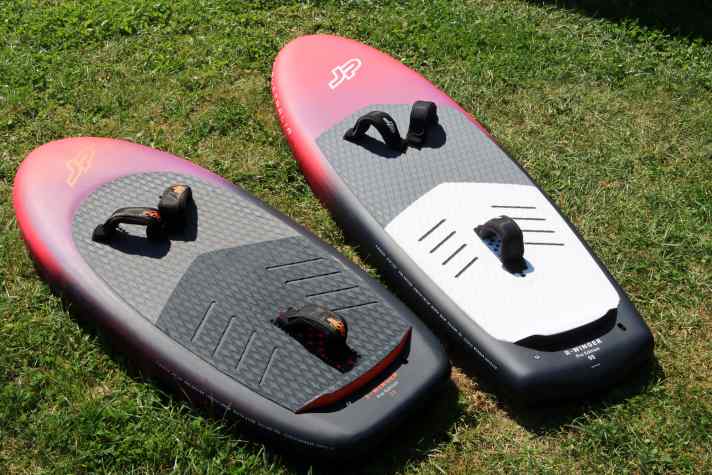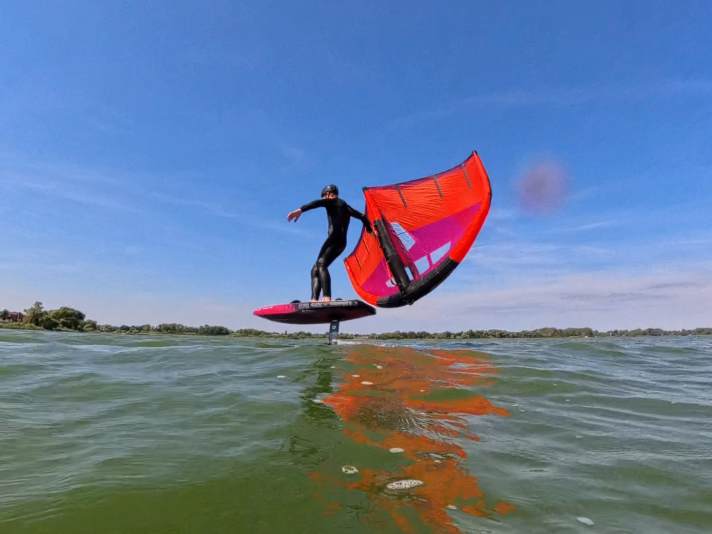





Longer than the classic compact wingboards, but easier to ride than the very narrow downwind boards - more and more manufacturers are trying to reconcile early take-off and easy handling with a new class of board. JP-Australia also has such a model in its range with the R-Winger - we tested the 95-litre version.
On land
The new R-Winger is available on the market in three sizes, with 65/80 and 95 litres. Compared to its sister model, the X-Winger (Here is a test) the R-Winger is around 25 centimetres longer and a full eight centimetres narrower with a comparable volume. The shape is uncompromisingly optimised for early take-off: the rocker line has been shaped very flat, while very sharp trailing edges in the tail area are designed to ensure the best possible water release. A carrying handle has been deliberately omitted to avoid additional resistance when starting off - this is understandable, but naturally less comfortable for longer journeys to the water. A non-slip pad has been glued to the deck and there are numerous loop positions available so that, in conjunction with the long foil box, you should be able to find a suitable setup for all board-foil combinations. Keyword "straps": These are exceptionally soft and comfortable and are also fastened with Torx screws - broken screw heads should therefore be a thing of the past. We measured the R-Winger at 5.98 kilos, which is a pleasingly light 95 litres.

On the water
The fact that the comparatively smaller width hardly has a negative impact in terms of tipping stability is mainly due to the fact that each mounted foil noticeably stabilises the longitudinal axis. In addition, due to its length, the board is more forgiving than average when it comes to load errors around the transverse axis and can therefore also be started by less experienced riders without any problems. The board has particular strengths when starting off passively: If you do not yet have a sophisticated pumping technique, you will reach the required take-off speed faster than with a wider and shorter wingboard such as the X-Winger, for example. If the acceleration is supported by active pumping, the lower wind limit can be noticeably reduced even further. Compared to the significantly narrower and longer downwind boards (HERE is a field report) the JP-Australia R-Winger can't keep up when it comes to taking off, but the concept still represents a sensible compromise. In contrast to downwind boards, the R-Winger can be ridden almost like a short wingboard in a straight line and is much easier to control in manoeuvres. The straps offer good contact with the board and the necessary control over the foil, regardless of whether you favour fast freeride runs or are honing your foil manoeuvres. Normal jumps are also easily possible with the R-Winger, but for rotations or even freestyle tricks, the concept naturally lacks the desired compactness, where compact models such as the X-Winger or F-Winger can do much more.

JP-Australia R-Winger - the conclusion
As envisaged by the manufacturer, the R-Winger concept lies exactly between the compact wingboards and narrow downwind concepts. It doesn't take off as early as a downwind board, but noticeably earlier than the current compact concepts. If you are looking for a board for effortless take-off at light wind spots and are put off by the extremely narrow downwind boards, this is a great concept for freeriding and even sporty racing with small foils. When jumping and freestyling, the concept understandably reaches its limits.
Easy take-off; Freeride & Racing
No carrying handle
-
JP-Australia R-Winger - technical data
- Test model: JP-Australia R-Winger 95
- Length: 6'0'' (183 cm)
- Width: 23'' (58 cm)
- Weight (own measurement, without straps): 5.98 kilos
- Volume: 95 litres
- Available sizes: 5'0''x65 // 5'5'' x80 // 6'0'' x95 litres
- Scope of delivery: Board, straps
- Price: 1999 Euro

